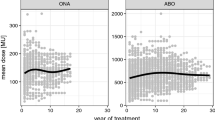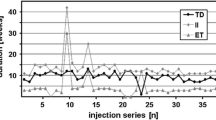Abstract.
Recently, botulinum toxin type B (BT-B) became commercially available for treatment of cervical dystonia. It is the aim of this study to explore its use for treatment of bilateral axillar hyperhydrosis (HH).
For this we directly compared the antihyperhydrotic effect of BT-B (NeuroBloc®/MyoBloc™) with that of botulinum toxin type A (BT-A) (Botox®). 9 patients (HD group) received BT-A 100MU unilaterally and BT-B 4000MU contralaterally. 10 patients (LD group) received BT-A 100MU and BT-B 2000MU. All patients were blinded as to which preparation was used in which side.
All patients except one reported excellent HH improvement in both axillae. None of the patients had residual HH on clinical examination. The duration of HH improvement until first recurrence in the HD group was 16.0 ±4.3 weeks in the BT-A treated axillar and 16.4 ±4.5 weeks in the BT-B treated axillae (Wilcoxon rank-sum test, p = 0.336). In the LD group it was 16.4 ±5.3 weeks in the BT-B treated axillae and 17.1 ±5.7 weeks in the BT-A treated axillae (Wilcoxon rank-sum test, p = 0.059). There was also no difference in the duration of HH improvement between the axillae treated with BT-B 4000MU and BT-B 2000MU (Wilcoxon rank-sum test, p = 0.712). 5 out of 9 patients in the HD group (chi-square test, p = 0.025) and 7 out of 10 patients in the LD group (chi-square test, p = 0.008) reported more application discomfort in the BT-B treated axillae. In 6 out of 9 patients in the HD group (chi-square test, p = 0.014) and in 6 out of 10 patients in the LD group (chi-square test, p = 0.014) the onset of HH improvement appeared earlier in the BT-B treated axillae. One patient in the HD group reported dryness of the mouth and eyes and accomodation difficulties.
BT-B is a safe and efficient treatment for axillar HH. Doses of BT-B 2000MU per axilla seem sufficient indicating a conversion factor between BT-A and BT-B in the order of 1:20. With a conversion factor for cervical dystonia in the order of 1:40 the autonomic nervous system seems to be relatively more sensitive to BT-B than to BT-A compared with the motor system.
Similar content being viewed by others
Author information
Authors and Affiliations
Additional information
Received: 18 March 2002, Accepted: 8 July 2002
Correspondence to Dirk Dressler, MD
Rights and permissions
About this article
Cite this article
Dressler, D., Adib Saberi, F. & Benecke, R. Botulinum toxin type B for treatment of axillar hyperhidrosis. J Neurol 249, 1729–1732 (2002). https://doi.org/10.1007/s00415-002-0929-4
Issue Date:
DOI: https://doi.org/10.1007/s00415-002-0929-4




